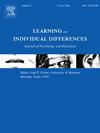职场自我调节学习:状态、特点还是发展?
IF 9
1区 心理学
Q1 PSYCHOLOGY, EDUCATIONAL
引用次数: 0
摘要
当健康科学专业的学生开始在工作场所学习和实践时,他们经常遇到挑战。在这种情况下,各种研究方法和干预措施已经开发出来,以促进自我调节学习。为了确定最有效的方法,有必要彻底了解工作场所自我调节学习的稳定性和可变性。目的分析工作场所自我调节学习的稳定特征、自回归特征和时变状态成分。样本包括188名本科生,他们是第一次在医疗工作场所学习,并且每周在不同的环境之间轮换。方法对大学生进行为期10周的自我调节学习的37个方面的日记。使用STARTS模型对数据进行分析。结果综合分析结果表明,职场自我调节学习的总方差中,稳定特质分量占28%,自回归特质分量占22%,时变状态分量占50%。这些组成比例在自我调节学习的不同领域(认知、动机、情感和情境)和水平(学习过程水平和元水平)中有所不同。结论要提高健康科学专业学生的职场自主学习能力,建议在承认个体差异和考虑阶段性干预的同时,重点研究和干预措施,提供情境化的支持框架条件。需要进一步的研究来确定这些发现是否可以应用于其他轮换间隔和学科领域。本文章由计算机程序翻译,如有差异,请以英文原文为准。
Self-regulated learning at the workplace: State, trait, or development?
Background
Health sciences students often encounter challenges when they begin learning and practicing in the workplace. Various research approaches and interventions have been developed to facilitate self-regulated learning in this context. To determine the most effective approach, a thorough understanding of the stability and variability of self-regulated learning in the workplace is necessary.
Aim
This study analyzed the stable trait, autoregressive trait, and time-varying state components of self-regulated learning in the workplace.
Sample
The sample comprised 188 undergraduates who were learning at a medical workplace for the first time and rotating weekly between various settings.
Methods
Undergraduates completed a diary on 37 aspects of self-regulated learning for a duration of 10 weeks. Data were analyzed using STARTS models.
Results
The aggregate results showed that 28 % of the total variance in self-regulated learning in the workplace was accounted for by the stable trait component, 22 % by the autoregressive trait component, and 50 % by the time-varying state component. These component ratios vary across different areas (cognition, motivation, emotion, and context) and levels (learning process level and metalevel) of self-regulated learning.
Conclusions
To enhance health sciences students' self-regulated learning in the workplace, it is recommended to focus on research and interventions to provide situation-specific supportive framework conditions while acknowledging individual differences and considering phase-specific interventions. Further research is required to determine whether these findings can be applied to other rotational intervals and subject areas.
求助全文
通过发布文献求助,成功后即可免费获取论文全文。
去求助
来源期刊

Learning and Individual Differences
PSYCHOLOGY, EDUCATIONAL-
CiteScore
6.60
自引率
2.80%
发文量
86
期刊介绍:
Learning and Individual Differences is a research journal devoted to publishing articles of individual differences as they relate to learning within an educational context. The Journal focuses on original empirical studies of high theoretical and methodological rigor that that make a substantial scientific contribution. Learning and Individual Differences publishes original research. Manuscripts should be no longer than 7500 words of primary text (not including tables, figures, references).
 求助内容:
求助内容: 应助结果提醒方式:
应助结果提醒方式:


